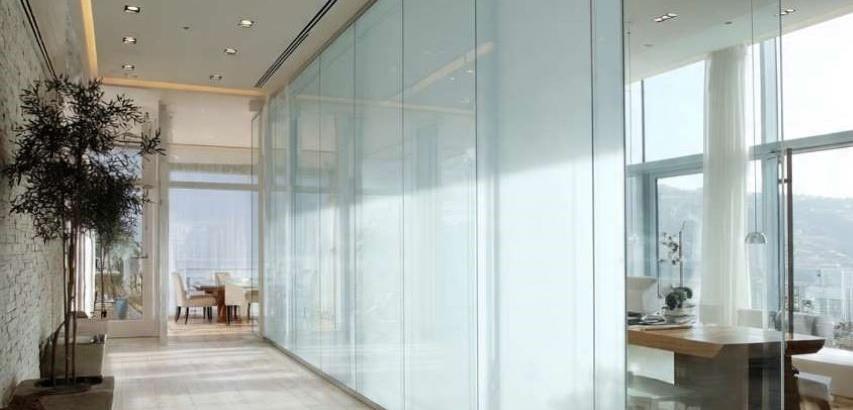Electric Smart Glass Film (often referred to as switchable film or privacy film) is a technologically advanced laminate that can be applied to existing glass surfaces, transforming them from transparent to opaque (and vice versa) at the flick of a switch. This on-demand privacy and light control technology is revolutionizing spaces in residential, commercial, and architectural design.
Core Technology: How It Works
The most common technology used in these films is Polymer Dispersed Liquid Crystal (PDLC).
Composition: The film is a sandwich of several layers. The core contains a thin layer of liquid crystal droplets suspended in a polymer, laminated between two layers of transparent conductive material (usually Indium Tin Oxide, or ITO), which are in turn sealed between durable PET (Polyethylene Terephthalate) plastic layers.
"Off" State (Opaque/Frosted): When no electrical current is applied, the liquid crystals are randomly scattered. They scatter incoming light in all directions, creating a translucent, "frosted glass" effect that provides privacy while still allowing diffuse light to pass through.
"On" State (Transparent/Clear): When an electrical current is applied, the electric field aligns the liquid crystals in an orderly fashion. This alignment allows light to pass through directly, making the glass clear and transparent, and restoring the full view.
This transition is instantaneous (typically less than a second) and can be repeated millions of times.
Key Components and Features
The Film Itself: A multi-layered, thin (typically 0.2mm to 0.8mm), flexible laminate.
The Power Supply: A low-voltage AC or DC power supply (usually 24V, 36V, or 60V) is required to operate the film. It consumes very little power, only drawing current to maintain the transparent state.
Control Mechanisms:
Simple Wall Switch: A standard-looking rocker or toggle switch.
Remote Control: RF or IR remotes for convenience.
Smart Home Integration: Can be connected to systems like Google Home, Amazon Alexa, Apple HomeKit, or Control4 via compatible controllers, allowing for voice commands, app control, and automation (e.g., "Good Morning" scene that opens blinds and clears the bathroom smart glass).
Motion Sensors & Timers: Can be programmed to turn clear or opaque based on occupancy or a schedule.
Types of Smart Glass Technologies
While PDLC film is the most common for retrofit applications, it's important to distinguish it from other technologies:
PDLC (Polymer Dispersed Liquid Crystal): The standard. Provides instant privacy but does not typically provide solar control or tinting. It switches between Clear ↔ Frosted.
SPD (Suspended Particle Device): Uses suspended particles that block light when off. It can be dimmed to variable levels of transparency, like a window shade, and offers better heat and glare rejection. It switches between Dark/Tinted ↔ Clear.
Electrochromic: A more common technology for insulated glass units (IGUs) rather than film. It changes color/tint slowly (over minutes) by moving ions across a layer. It's excellent for solar control but not for instant privacy.
Advantages and Benefits
Space Optimization & Flexibility: Eliminates the need for blinds, curtains, or partitions. A single room can instantly switch from a private office or bedroom to an open, airy space.
Modern Aesthetics: Provides a sleek, minimalist, and high-tech look that is highly sought after in contemporary architecture and interior design.
Energy Efficiency: In its opaque state, the film's diffusive properties can help reduce glare and, to some extent, solar heat gain, potentially lowering cooling costs. Newer generations are incorporating better thermal insulation properties.
UV Protection: Blocks over 99% of harmful UV rays, protecting interior furnishings, artwork, and fabrics from fading.
Hygiene & Safety: Unlike blinds and curtains that collect dust and allergens, the smooth glass surface is easy to clean and maintain. The film also adds a shatter-resistant layer, holding broken glass together.
Common Applications
Commercial: Conference room walls, office partitions, storefronts for after-hours product display, hospital room and clinic doors for patient privacy.
Residential: Bathroom windows and shower enclosures, room dividers, front door sidelights, skylights, and home offices.
Architectural & Retail: Building facades, museum display cases, restaurant partitions, and luxury retail spaces.
Limitations and Considerations
Power Dependency: It requires a constant electrical connection to remain transparent. If the power is cut, it defaults to the opaque state (for PDLC).
Cost: While becoming more affordable, it is a significant investment compared to traditional window treatments. The cost includes the film, professional installation, and the electrical work.
Clarity in "On" State: High-quality films are very clear, but they may have a very slight blue or hazy tint compared to raw glass.
Professional Installation Required: Proper installation is critical and involves a dust-free environment, precise cutting, and a meticulous lamination process to avoid bubbles, wrinkles, or edge peeling.
No Insulation in Opaque Mode: While it provides visual privacy, it does not provide significant acoustic insulation.
Electric Smart Glass Film is a transformative technology that merges the physical and digital worlds of building management. It offers an elegant, dynamic, and intelligent solution for managing privacy, light, and energy in modern living and working environments. By providing instantaneous control over the transparency of glass, it empowers users to redefine their spaces on demand, making it a cornerstone of smart, adaptive, and minimalist architectural design.
 |  |  |
 |  |  |
